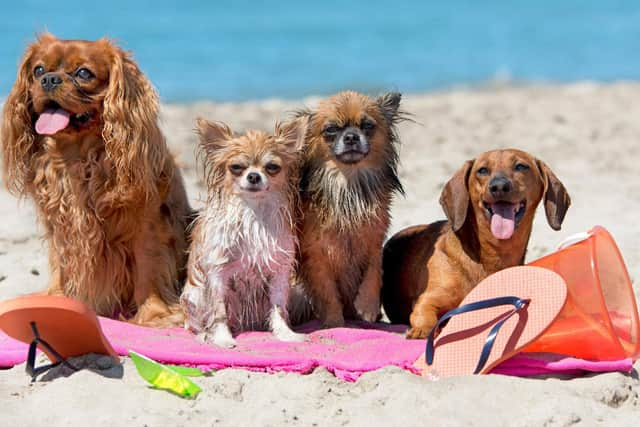Dog Beach Safety Tips: Here are 5 expert tips on keeping your adorable dog safe on the beach this summer
This article contains affiliate links. We may earn a small commission on items purchased through this article, but that does not affect our editorial judgement.
and live on Freeview channel 276
Sun, sea and sand are perfect for a warm day but, just like us humans need to remember to protect ourselves from the sun and keep rehydrated, our pups also need extra care.
To help out, dog-friendly accommodation experts C anine Cotta ges have revealed five dog-friendly tips to enjoy a pawfect day at the beach.
Advertisement
Hide AdAdvertisement
Hide AdA Canine Cottages spokesperson explained: “With the UK already recording its hottest temperature ever and more warm days ahead, it’s important to know the right steps to take to keep our dogs safe when on a family day out at the beach. We hope these tips help dog owners take the appropriate care when at the beach, to ensure optimum safety for our furry friends.”
Here’s what you need to keep in mind before heading to the coast with your pooch.
Understand if your dog can swim
While some dogs are natural born swimmers, others aren’t blessed with the ability to swim, so you should never assume that your dog will find their sea legs in the water. It’s important to teach your pooch to swim if they can’t already. Their first instinct will only be to paddle with their front legs, so encourage them to kick with their back legs in the water too by holding their belly just above the water. If they start to panic, then it’s important to take them out the water and try another day! A dog life vest will also help ensure your dog is safe in the water too.
Ensure the water is safe for swimming


The British seaside can be temperamental, and even if it’s a hot sunny day, the sea can still be cold. Don’t take your pooch swimming on a particularly cool day and make sure that your dog doesn’t get too cold in the sea and look out for warning signs, like shaking or shivering. If so, then make sure you get them out as quick as possible. Check out for strong current alerts before swimming too.
Advertisement
Hide AdAdvertisement
Hide AdYou should also check beach flags for warmings before swimming with your pooch:
R ed and white pr obation sign – do not enter the water
No lifeguards sign – this beach is not lifeguarded. You can still enter the water but do so at your own risk
Red and yellow sign – lifeguarded area for swimming, bodyboarding and using inflatables
Black and white sign – area for surfing and using any other non-powered craft. No swimming
Red flag – danger, do not go into the water
Orange flag – indicates offshore or strong wind
Find fresh water and hydrate
Advertisement
Hide AdAdvertisement
Hide AdDuring summer, you should always ensure your dog is kept hydrated, and especially during a day out at the beach. Keep your dog’s water bowl to the beach and top up regularly with fresh water. And although it’s normal for our dogs to drink a little seawater here and then, it can make our pooches sick, so make sure they’re not swallowing too much when out in the water.
Keep a look out for dangerous items
A lot of dangerous objects can be hidden in the sand at the beach that can hurt our pets, such as glass, rocks, cans, coral or even hooks. It’s a good idea to ensure your dog doesn’t go digging too far
in the sand, and check yourself for any dangers before allowing your pooch to explore the area. When in the sea, be wary of uneven surfaces or rocks under the surface that can also hurt your pooch.
Apply sun cream
Just like humans, our pooches are susceptible to painful sun burn – but many pet owners are unaware of this! Short-hair breeds and dogs with white/light-coloured fur are most at risk of sunburn, and their lips, noses, ears and belly are most vulnerable to the sun. That’s why you should keep your dog in the shade as much as possible, which will also stop them preventing heatstroke. You can also buy pet-friendly sunscreen to take with you too.
Advertisement
Hide AdAdvertisement
Hide AdComment Guidelines
National World encourages reader discussion on our stories. User feedback, insights and back-and-forth exchanges add a rich layer of context to reporting. Please review our Community Guidelines before commenting.